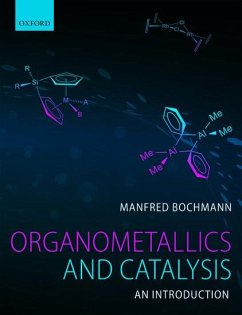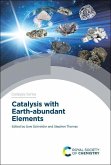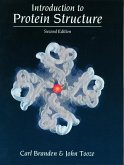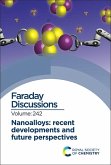Manfred Bochmann (School of Chemistry, University of East Anglia, N
Organometallics and Catalysis: An Introduction
Manfred Bochmann (School of Chemistry, University of East Anglia, N
Organometallics and Catalysis: An Introduction
- Broschiertes Buch
- Merkliste
- Auf die Merkliste
- Bewerten Bewerten
- Teilen
- Produkt teilen
- Produkterinnerung
- Produkterinnerung
A succinct review of the essential concepts of organometallic chemistry, enriched throughout with examples that demonstrate how our understanding of organometallic chemistry has led to new applications in research and industry - not least in relation to catalysis.
Andere Kunden interessierten sich auch für
![Topics In Enantioselective Catalysis: Recent Achievements And Future Challenges Topics In Enantioselective Catalysis: Recent Achievements And Future Challenges]() Topics In Enantioselective Catalysis: Recent Achievements And Future Challenges172,99 €
Topics In Enantioselective Catalysis: Recent Achievements And Future Challenges172,99 €![Catalysis with Earth-Abundant Elements Catalysis with Earth-Abundant Elements]() Catalysis with Earth-Abundant Elements252,99 €
Catalysis with Earth-Abundant Elements252,99 €![The Organometallic Chemistry of the Transition Metals The Organometallic Chemistry of the Transition Metals]() Robert H. Crabtree (Yale University)The Organometallic Chemistry of the Transition Metals98,99 €
Robert H. Crabtree (Yale University)The Organometallic Chemistry of the Transition Metals98,99 €![The Basis and Applications of Heterogeneous Catalysis The Basis and Applications of Heterogeneous Catalysis]() Michael Bowker (Professor of Physi Professor of Physical ChemistryThe Basis and Applications of Heterogeneous Catalysis45,99 €
Michael Bowker (Professor of Physi Professor of Physical ChemistryThe Basis and Applications of Heterogeneous Catalysis45,99 €![Introduction to Protein Structure Introduction to Protein Structure]() Carl Ivar BrandenIntroduction to Protein Structure108,99 €
Carl Ivar BrandenIntroduction to Protein Structure108,99 €![Chiral Phosphorous Based Ligands in Earth-Abundant Transition Metal Catalysis Chiral Phosphorous Based Ligands in Earth-Abundant Transition Metal Catalysis]() Chiral Phosphorous Based Ligands in Earth-Abundant Transition Metal Catalysis244,99 €
Chiral Phosphorous Based Ligands in Earth-Abundant Transition Metal Catalysis244,99 €![Nanoalloys: Recent Developments and Future Perspectives Nanoalloys: Recent Developments and Future Perspectives]() Nanoalloys: Recent Developments and Future Perspectives227,99 €
Nanoalloys: Recent Developments and Future Perspectives227,99 €-
-
-
A succinct review of the essential concepts of organometallic chemistry, enriched throughout with examples that demonstrate how our understanding of organometallic chemistry has led to new applications in research and industry - not least in relation to catalysis.
Hinweis: Dieser Artikel kann nur an eine deutsche Lieferadresse ausgeliefert werden.
Hinweis: Dieser Artikel kann nur an eine deutsche Lieferadresse ausgeliefert werden.
Produktdetails
- Produktdetails
- Verlag: Oxford University Press
- Seitenzahl: 432
- Erscheinungstermin: 11. Dezember 2014
- Englisch
- Abmessung: 241mm x 187mm x 20mm
- Gewicht: 744g
- ISBN-13: 9780199668212
- ISBN-10: 0199668213
- Artikelnr.: 42388517
- Herstellerkennzeichnung
- Libri GmbH
- Europaallee 1
- 36244 Bad Hersfeld
- gpsr@libri.de
- Verlag: Oxford University Press
- Seitenzahl: 432
- Erscheinungstermin: 11. Dezember 2014
- Englisch
- Abmessung: 241mm x 187mm x 20mm
- Gewicht: 744g
- ISBN-13: 9780199668212
- ISBN-10: 0199668213
- Artikelnr.: 42388517
- Herstellerkennzeichnung
- Libri GmbH
- Europaallee 1
- 36244 Bad Hersfeld
- gpsr@libri.de
Manfred Bochmann is Professor of Inorganic Chemistry and Director of the Wolfson Materials and Catalysis Centre at the University of East Anglia where his research centres broadly around synthetic organometallic and coordination chemistry directed towards homogeneous catalysis. A former Head of the School of Chemistry, in 2003 he was awarded the Royal Society of Chemistry Medal for Organometallic Chemistry. Professor Bochmann is the author of two Oxford Chemistry Primers on organometallic chemistry, and is an Associate Editor of the journal Organometallics.
Part 1. Organometallic Compounds of Main Group Elements
1.1: General and bonding considerations
1.2: Alkali metal organometallics: lithium
1.3: Organometallic compounds of alkaline earth metals
1.4: Zinc, cadmium and mercury
1.5: Organometallic compounds of the boron group
1.6: Organometallic compounds of the carbon group
Part 2. Organometallic Compounds of Transition Metals
2.1: Ligand types
2.2: Common types of organometallic complexes
2.3: Electron counting and the 16/18-electron rule
2.4: Ligand properties and metal-ligand bonding
2.5: L-type
p-acceptor ligands : metal carbonyl complexes
2.6: L-type
p-acceptor ligands: alkenes, dienes and alkynes
2.7: LX- and L2X-type
p-acceptor ligands: allyl and enyl complexes
2.8: L2X-type
p-acceptor ligands: metallocene complexes
2.9: Arene complexes
2.10: Sigma complexes
2.11: Complexes with M-C
s-bonds
2.12: Alkylidene complexes
2.13: Complexes with MC triple bonds: carbynes
Part 3. Homogeneous Catalysis with Organometallic Transition Metal Complexes
3.1: General considerations
3.2: Key reaction steps in homogeneous catalysis
3.3: Catalytic H-H and H-X additions
3.4: Catalytic carbonylations
3.5: Alkene oxidations
3.6: Coupling reactions
3.7: Alkene polymerizations
Appendix 1 Commonly used solvents and their properties
Appendix 2 Number and symmetry of infrared-active vibrations of metal carbonyl complexes
Appendix 3 Answers to exercises
Appendix 4 Further reading
1.1: General and bonding considerations
1.2: Alkali metal organometallics: lithium
1.3: Organometallic compounds of alkaline earth metals
1.4: Zinc, cadmium and mercury
1.5: Organometallic compounds of the boron group
1.6: Organometallic compounds of the carbon group
Part 2. Organometallic Compounds of Transition Metals
2.1: Ligand types
2.2: Common types of organometallic complexes
2.3: Electron counting and the 16/18-electron rule
2.4: Ligand properties and metal-ligand bonding
2.5: L-type
p-acceptor ligands : metal carbonyl complexes
2.6: L-type
p-acceptor ligands: alkenes, dienes and alkynes
2.7: LX- and L2X-type
p-acceptor ligands: allyl and enyl complexes
2.8: L2X-type
p-acceptor ligands: metallocene complexes
2.9: Arene complexes
2.10: Sigma complexes
2.11: Complexes with M-C
s-bonds
2.12: Alkylidene complexes
2.13: Complexes with MC triple bonds: carbynes
Part 3. Homogeneous Catalysis with Organometallic Transition Metal Complexes
3.1: General considerations
3.2: Key reaction steps in homogeneous catalysis
3.3: Catalytic H-H and H-X additions
3.4: Catalytic carbonylations
3.5: Alkene oxidations
3.6: Coupling reactions
3.7: Alkene polymerizations
Appendix 1 Commonly used solvents and their properties
Appendix 2 Number and symmetry of infrared-active vibrations of metal carbonyl complexes
Appendix 3 Answers to exercises
Appendix 4 Further reading
Part 1. Organometallic Compounds of Main Group Elements
1.1: General and bonding considerations
1.2: Alkali metal organometallics: lithium
1.3: Organometallic compounds of alkaline earth metals
1.4: Zinc, cadmium and mercury
1.5: Organometallic compounds of the boron group
1.6: Organometallic compounds of the carbon group
Part 2. Organometallic Compounds of Transition Metals
2.1: Ligand types
2.2: Common types of organometallic complexes
2.3: Electron counting and the 16/18-electron rule
2.4: Ligand properties and metal-ligand bonding
2.5: L-type
p-acceptor ligands : metal carbonyl complexes
2.6: L-type
p-acceptor ligands: alkenes, dienes and alkynes
2.7: LX- and L2X-type
p-acceptor ligands: allyl and enyl complexes
2.8: L2X-type
p-acceptor ligands: metallocene complexes
2.9: Arene complexes
2.10: Sigma complexes
2.11: Complexes with M-C
s-bonds
2.12: Alkylidene complexes
2.13: Complexes with MC triple bonds: carbynes
Part 3. Homogeneous Catalysis with Organometallic Transition Metal Complexes
3.1: General considerations
3.2: Key reaction steps in homogeneous catalysis
3.3: Catalytic H-H and H-X additions
3.4: Catalytic carbonylations
3.5: Alkene oxidations
3.6: Coupling reactions
3.7: Alkene polymerizations
Appendix 1 Commonly used solvents and their properties
Appendix 2 Number and symmetry of infrared-active vibrations of metal carbonyl complexes
Appendix 3 Answers to exercises
Appendix 4 Further reading
1.1: General and bonding considerations
1.2: Alkali metal organometallics: lithium
1.3: Organometallic compounds of alkaline earth metals
1.4: Zinc, cadmium and mercury
1.5: Organometallic compounds of the boron group
1.6: Organometallic compounds of the carbon group
Part 2. Organometallic Compounds of Transition Metals
2.1: Ligand types
2.2: Common types of organometallic complexes
2.3: Electron counting and the 16/18-electron rule
2.4: Ligand properties and metal-ligand bonding
2.5: L-type
p-acceptor ligands : metal carbonyl complexes
2.6: L-type
p-acceptor ligands: alkenes, dienes and alkynes
2.7: LX- and L2X-type
p-acceptor ligands: allyl and enyl complexes
2.8: L2X-type
p-acceptor ligands: metallocene complexes
2.9: Arene complexes
2.10: Sigma complexes
2.11: Complexes with M-C
s-bonds
2.12: Alkylidene complexes
2.13: Complexes with MC triple bonds: carbynes
Part 3. Homogeneous Catalysis with Organometallic Transition Metal Complexes
3.1: General considerations
3.2: Key reaction steps in homogeneous catalysis
3.3: Catalytic H-H and H-X additions
3.4: Catalytic carbonylations
3.5: Alkene oxidations
3.6: Coupling reactions
3.7: Alkene polymerizations
Appendix 1 Commonly used solvents and their properties
Appendix 2 Number and symmetry of infrared-active vibrations of metal carbonyl complexes
Appendix 3 Answers to exercises
Appendix 4 Further reading








